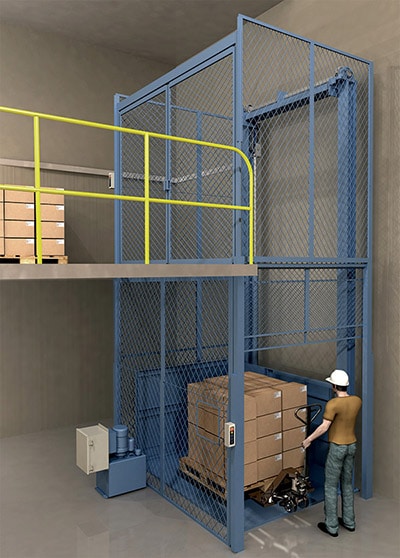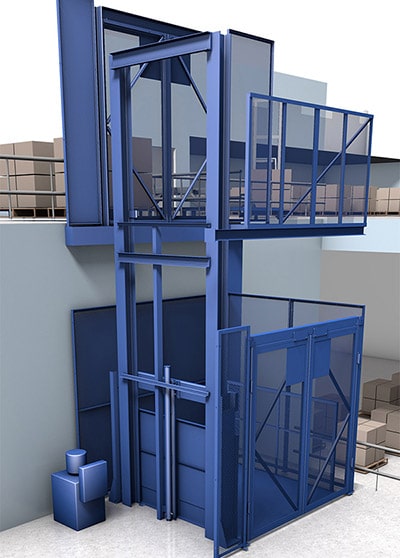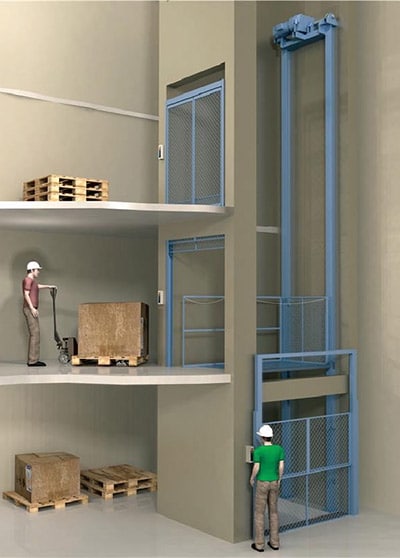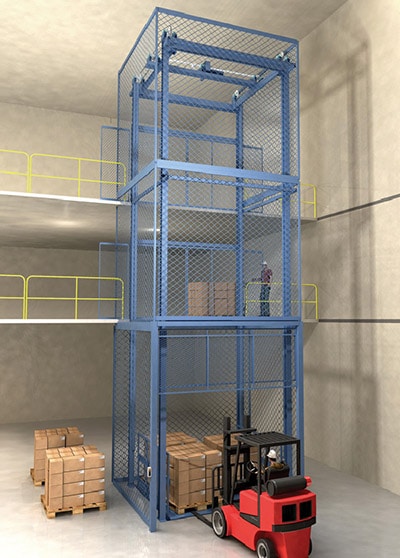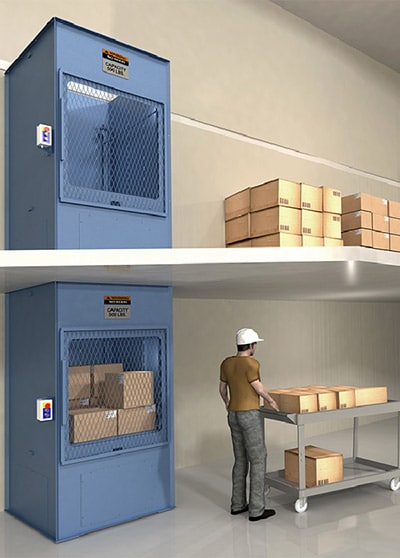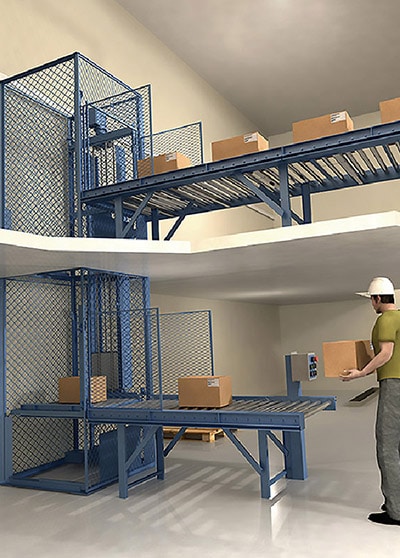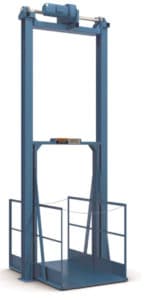Mechanical VRCs
PFlow mechanical lifts use a chain over sprocket lifting design to ensure smooth travel and bounce-free stops to multiple levels. Whether you are in need of a pallet lift or your application requires moving boxes, totes, or large machinery, PFlow’s mechanical lifts can meet your needs. Designed to withstand the rigors of unlimited use, PFlow mechanical lifts can transport loads from 100 lbs to over 200,000 lbs. All lifts come with a lifetime structural warranty.
Let our VRC experts help you determine the right mechanical VRC for your specific application.
4-Post F Series
Mechanical VRC
The 4-Post F Series mechanical lift (VRC) is capable of lifting the largest, bulkiest, and heaviest materials. It can handle loads up to 200,000 lbs. Because of its 4-post design, the F Series accommodates loading and unloading from all sides.
- Unlimited carriage size
- Unlimited vertical rise
- Standard travel speed of 18 FPM, with 400 FPM possible
- Unlimited cycles per hour/day
- Indoor or outdoor use
2-Post M Series
Mechanical VRC
The 2-Post M Series mechanical lift (VRC) can safely lift loads up to 10,000 lbs to any number of floor levels. Available in straddle or cantilever configurations, it is perfect for automated, high-speed / high-cycle applications.
- Standard carriage size of 12’ x 10’
- Unlimited vertical rise
- Standard travel speed of 25 FPM, with 400 FPM possible
- Unlimited cycles per hour/day
- Indoor or outdoor use
B Series
Box Lift
The B Series box lift transports loads up to 500 lbs and is ideal for automatically moving boxes, totes, cartons, cases and individual parts from one level to another. It can be loaded and unloaded at 3 sides from each level.
- Carriage size is 3’x3′
- Vertical rise to 15’9″
- Standard travel speed of 30 FPM
- Unlimited cycles per hour/day
- Indoor use only
- Loading position - 30" above floor
DB Series
Package Handling Lift
The DB Series package handling lift is designed for moving loads up to 100 lbs between floors or conveyor levels. Loading and unloading is available from 3 sides. The DB Series is ideal for automated package handling and is completely self-contained.
- 3’x3’ standard carriage size
- Vertical rise up to 20'
- Standard travel speed of 60 FPM
- Unlimited cycles per hour/day
- Indoor use only
Need Help Deciding?
PFlow Industries manufactures vertical reciprocating conveyors to solve any material lifting need. Use our configurator to find the perfect lift for your application, and then we’ll design it to your exact requirements.
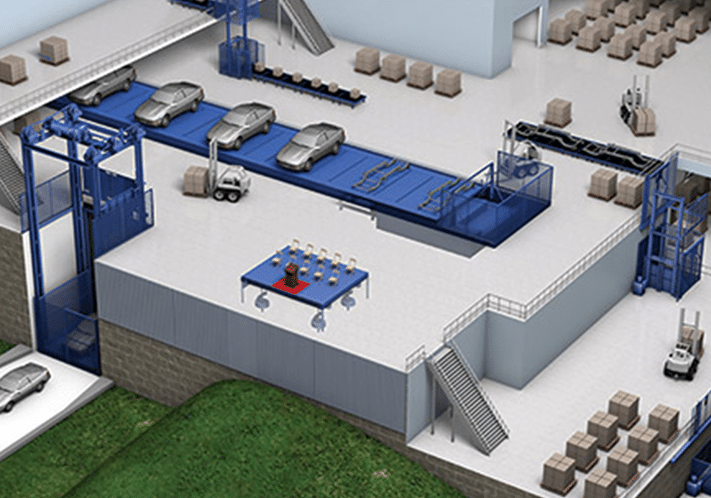
VRC Applications
- Freight
- Pallets
- Mezzanines
- Materials
PFlow Industries Served
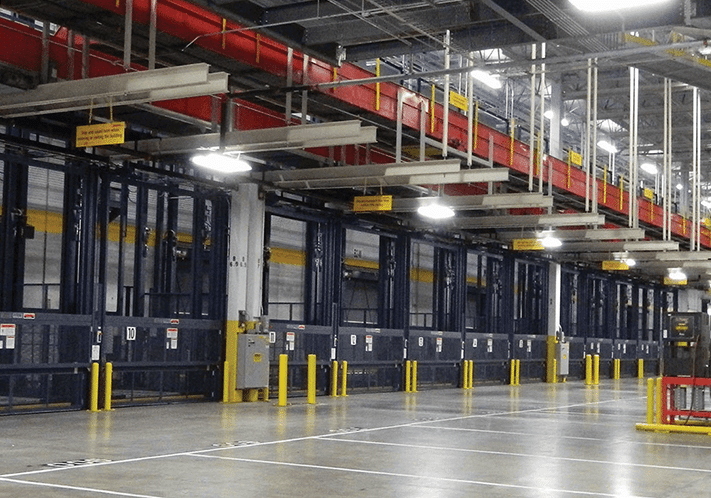
Vertical Reciprocating Conveyors (VRCs)
Don’t see your question below? Contact us to get help.
We offer a wide range of mechanical VRCs that can lift anywhere from 50,000 to 200,000 lbs. Each lift comes with several essential features, such as:
- Safety gates (swing, sliding, and vertical acting designs)
- Enclosures to protect both workers and materials
- Safety cams (to prevent carriage descent in the unlikely event of a lifting chain break)
- DeckLock safety system
Mechanical lifts offer a wide range of benefits, such as:
- Unlimited hourly/daily cycles
- Unlimited load capacity
- Unlimited rise
- Ideal for high-cycle, high-speed, or automated systems
The lift dimensions vary depending on the model and your specific requirements. Please check out the CAD drawings in our Knowledge Base for precise dimensions or contact one of our knowledgeable PFlow representatives or dealers for more information.
Yes. ANSI, ASME, OSHA, and good old-fashioned common safety sense dictate that anywhere a human being can come into contact with a vertical conveyor lift, you will need an enclosure. A safety gate with an interlock mechanism is mandated at the loading point of the lift. Safety first.
- Hydraulic lifts have limited vertical rise and are therefore used in 2-level lifting applications. Mechanical lifts have unlimited vertical rise, allowing access to unlimited floor levels.
- Hydraulic VRCs have a lower initial cost but they require more ongoing maintenance than mechanical VRCs.
- A hydraulic lift has limited cycles per hour and per day and mechanical lifts are designed for unlimited use.
- Hydraulic VRCs are intended to lift up to 6,000 lbs payloads versus an almost unlimited payload capacity for mechanical lifts.
We typically prepare and send out approval drawings within two to three weeks after receiving an order for a material handling product. A standard lift has a general shipped lead time of 14 to 16 weeks after returning the signed approval drawing to PFlow Industries.
Payload capacity, vertical rise, and cycle use requirements are just a few of the many things you will need to consider when choosing the right vertical reciprocating conveyor. Check out the calculator on our Product Configurator page for a more detailed look at which mechanical lift will best suit your application.
When compared to hydraulic lifts, mechanical lifts require less maintenance. For a more detailed look at maintenance requirements, check out the Preventive Maintenance section in the Knowledge Base.
No! Federal, state and local codes prohibit the transport of people within a mechanical (or hydraulic) VRC. Mechanical lifts are only to be used for transporting materials.
There are six basic lift installation steps:
- Columns are set in place and temporarily braced
- The carriage is placed between the columns and attached
- Gates are assembled, set in place, anchored, and braced
- Enclosures are assembled, set in place, and anchored
- Wiring of electrical components (made easier when you select PFlow’s quick connect cabling option that pre-wires the push-button controllers, motor pump, and gate interlocks.

